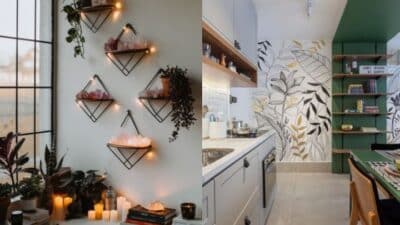Spring is the perfect time to refresh your home with cheerful, seasonal decor that won’t break the bank. With just a few simple supplies and some creativity, you can transform your space into a spring haven that celebrates the season’s renewal. Creating beautiful DIY spring decor allows you to personalize your home while staying within budget, as many stunning projects can be made using items from nature, dollar stores, or materials you already have on hand.
From repurposing vintage windows and framing seasonal prints to crafting macrame wreaths and whitewashing terracotta pots, spring decorating possibilities are endless. Consider shopping your own yard for blooming branches, crafting with unexpected materials like coffee filters, or using book pages to create unique seasonal touches throughout your home. These simple projects can bring fresh energy to spaces like your mantel, tablescape, or even a small corner of your bathroom sink.
Key Takeaways
- Budget-friendly DIY spring decor can be created using dollar store finds, natural elements from your yard, and simple crafting techniques.
- Personalizing your space with handmade seasonal touches creates a more authentic and meaningful home environment.
- Incorporating spring elements like fresh colors, botanical elements, and lighter textures instantly refreshes your home for the new season.


Planning Your DIY Spring Decor Project
Before diving into your spring decorating projects, take time to plan your approach. A well-thought-out plan helps ensure your DIY creations align with your vision and available resources.
Selecting a Theme and Color Palette
Start by choosing a spring theme that resonates with your personal style. Popular options include garden-inspired, farmhouse spring, or minimalist floral designs. Draw inspiration from nature’s renewal during this season.
Consider a color palette that evokes springtime feelings. Pastels like mint green, soft pink, and pale yellow work beautifully for spring decor. You can also incorporate vibrant accents like coral or turquoise for visual interest.
Create a mood board using magazine cutouts, Pinterest images, or fabric swatches to visualize your theme and colors together. This helps ensure cohesiveness across your projects.
Remember that your theme should complement your existing home decor. Look for ways to refresh your space without completely overhauling it.
Assessing Materials and Space
Take inventory of materials you already have before purchasing new supplies. Check for:
- Craft basics: Paint, brushes, glue, scissors
- Natural elements: Branches, pinecones, flowers from your yard
- Repurposable items: Mason jars, picture frames, old books
Measure the spaces where you plan to place your spring decor. Note dimensions of mantels, tabletops, and wall areas to ensure your projects fit appropriately.
Consider your budget constraints. Dollar stores offer affordable materials for high-end looking projects. Thrift stores are excellent sources for unique items that can be transformed with paint or other embellishments.
Plan projects that match your skill level and available time. Start with simpler projects if you’re new to DIY home decor.


Creating a Fresh Spring Tablescape
A well-designed spring tablescape brings the season’s beauty to your dining experience through thoughtful tableware selection and natural elements. With simple DIY touches, you can transform an ordinary table into a celebration of spring’s renewal and freshness.
Choosing Tableware and Linens
Start with a color palette that reflects spring—soft pastels, fresh greens, or vibrant florals work beautifully. Layer your table with textured linens like a simple linen tablecloth or natural fiber placemats to create depth.
Mix and match tableware for an eclectic yet cohesive look. Consider these options:
- White plates as a versatile base
- Colored glassware that complements your palette
- Vintage pieces for character and charm
Napkins can be folded simply or tied with twine and adorned with a sprig of herbs. For place cards, use small terracotta pots with handwritten tags or pressed flowers in small frames.
Incorporating Natural Elements and Greenery
Fresh greenery forms the backbone of a spring tablescape. Create a low centerpiece using a mix of seasonal blooms, branches, and foliage that allows for conversation across the table.
Try these DIY natural elements:
- Mason jars filled with wildflowers or tulips
- Small potted herbs that double as favors
- Scattered citrus fruits for color and fragrance
Incorporate unexpected greenery like fern fronds, eucalyptus, or olive branches laid directly on the table. Small bud vases with single stems placed at each setting add personal touches.
For evening gatherings, add unscented candles in varying heights. Nestle them among your greenery for a warm, inviting glow that highlights your thoughtfully arranged spring tablescape.


Spring Floral Arrangements and Wreaths
Bringing the beauty of spring indoors through floral designs adds instant freshness to any space. These decorative elements capture the essence of the season with vibrant colors and natural textures.
Crafting Homemade Floral Centerpieces
Start with a suitable container like a mason jar, vintage pitcher, or low bowl to create stunning spring centerpieces. Choose seasonal flowers such as tulips, daffodils, and ranunculus in complementary colors that match your home’s palette.
Create depth by incorporating different heights and textures. Place taller stems toward the center and shorter blooms around the edges. Add greenery like eucalyptus or ferns for a lush backdrop that makes colors pop.
For longevity, change the water every two days and trim stems at an angle. Consider unconventional vessels like teacups, wooden boxes, or hollowed-out fruits for unique displays that showcase your creativity.
Mix in unexpected elements like branches, decorative eggs, or butterfly accents to enhance the spring theme without overwhelming your arrangement.
Designing and Constructing Spring Wreaths
Select a sturdy base like a grapevine wreath as your foundation. These natural forms provide excellent texture and grip for attaching decorative elements without excessive gluing.
Gather your materials before starting: floral stems, greenery (2 bushes typically suffice), quality ribbon, and a hot glue gun. Artificial flowers work best for lasting wreaths, but preserved or dried flowers offer a natural alternative.
Begin by attaching greenery evenly around the wreath to create fullness. Work in sections, layering stems at different angles for dimension.
Add focal flowers in groups of three for visual balance. Place larger blooms first, then fill gaps with smaller flowers and accent pieces.
Finish with a complementary ribbon bow or streamers. For added durability, spray your completed wreath with UV-resistant clear coat if you plan to hang it outdoors.



Incorporating Plants and Succulents
Plants and succulents breathe life into spring decor, offering vibrant colors and textures that transform any space. They provide an affordable way to refresh your home while connecting with nature.
Selecting the Right Plants for Your Space
Start by assessing your home’s lighting conditions before choosing plants. South-facing windows provide bright light ideal for succulents and cacti, while north-facing windows suit shade-loving plants like ferns and peace lilies.
Consider your maintenance capabilities honestly. Succulents require minimal watering and thrive on neglect, making them perfect for busy households or beginners. For low-light areas, try pothos, snake plants, or ZZ plants that adapt well to indoor conditions.
Scale matters too. Smaller spaces benefit from petite plants on shelves or windowsills, while larger rooms can accommodate statement floor plants. Remember that grouping plants creates visual impact and improves humidity for tropical varieties.
DIY Planters and Pot Decor
Transform ordinary containers into custom planters that complement your spring decor. Repurpose vintage doughbowls, teacups, or even plastic Easter eggs as unexpected succulent holders for under $0.50 each.
Create an eye-catching succulent centerpiece using varied container heights. Try arranging terracotta pots of different sizes, adding moss for texture, and incorporating natural elements like eucalyptus or twigs for dimension.
For a portable display option, craft a succulent garland in under 15 minutes. This versatile decoration works on mantels, tables, or as wall art. Simply secure small succulents to a base of twine or thin rope using floral wire.
Personalize plain pots with paint, washi tape, or fabric wraps. Consider adding drainage holes to non-traditional containers to prevent root rot. Grouping containers with complementary colors creates a cohesive spring display that highlights your plants’ natural beauty.


Adding Texture with Fabrics and Moss
Incorporating textural elements into your spring decor creates visual interest and depth in your space. Fabrics offer an easy way to introduce seasonal colors and patterns through throw pillows, table runners, or light curtains.
Moss is an excellent complement to fabrics, bringing natural texture and vibrant green tones to your spring decorating scheme. As the search results suggest, moss can be versatile in home decor and works beautifully across various applications.
Try creating a moss wreath for your front door or interior walls. Simply attach sheet moss to a foam wreath form using floral pins for an instant spring refresh.
Use moss as bowl filler for coffee table arrangements. Combine it with decorative eggs or other spring elements for a seasonal centerpiece that requires minimal effort.
Moss-lined containers add an earthy touch to your floral displays. Line a basket or decorative pot with sheet moss before adding fresh spring flowers or plants.
Simple Moss Project Ideas:
- Create table runners using preserved moss
- Fill glass jars or terrariums with moss for easy greenery
- Add moss to candle holders for woodland-inspired centerpieces
- Use moss in planter arrangements to cover soil and retain moisture
You can purchase preserved moss at craft stores, making it accessible for DIY projects. The natural green color instantly evokes spring freshness while adding organic texture to your decor.
Pairing different fabric textures with moss creates a balanced look. Consider linen, cotton, or even burlap alongside moss elements for a cohesive spring aesthetic that appeals to multiple senses.
- 19shares
- Facebook0
- Pinterest19
- Twitter0



